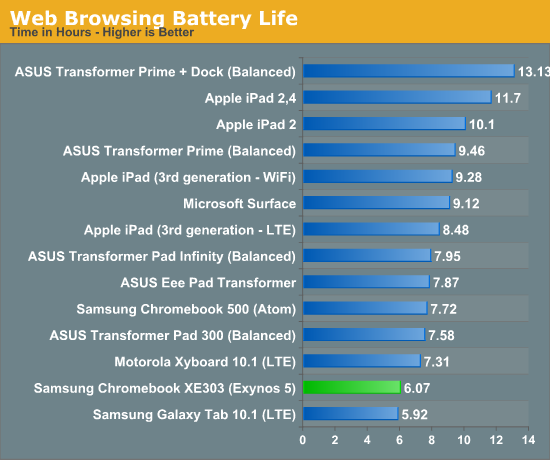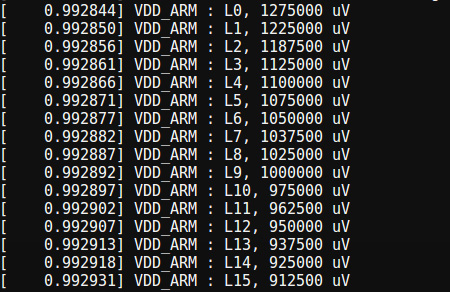Samsung Chromebook (XE303) Review: Testing ARM's Cortex A15
by Anand Lal Shimpi on October 31, 2012 9:00 AM ESTBattery Life & Power Analysis
The final unknown in all of this is power consumption. ARM's Cortex A15 isn't really supposed to be a sipper of power, and when placed in a notebook I don't know that there's a lot we can conclude about how it stacks up to Atom either. Some high level power consumption data would normally help but these two platforms are fairly different:
| Samsung Chromebook Power Consumption Comparison | ||||||
| Display @ 200 nits | Idle | Kraken (Avg) | Kraken (Peak) | |||
| Samsung Chromebook 500 (Atom N570) | 11.53W | 14.4W | 15.2W | |||
| Samsung Chromebook 303 (Exynos 5 Dual) | 6.33W | 10.5W | 11.3W | |||
The new Chromebook consumes considerably less power at idle than its predecessor. The smaller display, simplified motherboard and truly integrated SoC platform are likely all to thank for this. The significant reduction in power also helps explain the big reduction in battery capacity as well.
Under load, the two platforms do see differing levels of additional power consumption. The new Exynos 5 based Chromebook sees a dramatic increase in power consumption under load, hitting 10.5W (a 66% increase over idle) while running Mozilla's Kraken benchmark. The Atom N570 based Chromebook increases power consumption as well, but just not by as significant a degree: ~25%. This actually helps illustrate exactly why Atom wasn't phone worthy in its earlier incarnations. Contrary to popular belief, it wasn't actually peak power consumption that was the problem (a move to 32nm can easily eat into these numbers). The total platform power consumption, particularly at idle, was Atom's real problem in the early days. It also turns out that this is much of what keeps Intel's Core processors from moving into ultra mobile form factors, something that Haswell is supposed to address.
Given that we're dealing with somewhat different panels here, I wanted to see what power consumption looked like if we removed the panels from the equations. I re-ran all of the power data with the display turned off:
| Samsung Chromebook Power Consumption Comparison | ||||||
| Display Off | Idle | Kraken (Avg) | Kraken (Peak) | |||
| Samsung Chromebook 500 (Atom N570) | 8.82W | 11.4W | 12.4W | |||
| Samsung Chromebook 303 (Exynos 5 Dual) | 4.07W | 8.32W | 9.27W | |||
The old Atom based Chromebook uses more than twice the idle power of the new version - it's no wonder Google was able to get away with a battery half the size. Once again however we see a much larger increase in power consumption once the Cortex A15 is under heavy load. Active power consumption more than doubles on the new Chromebook, while we see around a 30% increase on the Atom based system. I do wonder what will have to be done to get the Exynos 5 Dual into a smartphone as an increase of ~4W under load just won't cut it in a phone. The Atom platform shows a 2.6W increase in power under load, which sounds about right for a high clocked 45nm part.

Despite the more power efficient platform, the reduction in battery capacity puts the new Chromebook well below the Atom model in battery life. Our wireless web browsing test put the new Chromebook at just over 6 hours of continuous use on a single charge. For a notebook that's not too bad, but compared to modern tablets it's not good.

The performance gains over Atom (and by extension, the ARM Cortex A9) do give us some indication as to what could be done to get Exynos 5 into a smartphone. By dropping clocks much lower than 1.7GHz Samsung would be able to maintain a performance advantage in a very power constrained device and hopefully keep power in check. The photo above features a list of all of the voltage levels supported by Samsung's Exynos 5 Dual as implemented in the new Chromebook.










149 Comments
View All Comments
garfnodie - Thursday, November 15, 2012 - link
Let's see, Chromebook for $249, or Transformer w/ keyboard for $600. I'm guessing if you'r a broke college student who needs something simple, the Chromebook is looking pretty good.Myrandex - Wednesday, October 31, 2012 - link
Eh instead of the Nexus 10 + keyboard, Microsoft Surface all the way!Krysto - Thursday, November 1, 2012 - link
Why? I want a good high-res screen on my device if I'm going to $400, which is $100 cheaper and has the same amount of free storage as Surface.qwerty321 - Wednesday, March 20, 2013 - link
Not for long. When PNaCl is stabilised, ChromeOS users will be able to install native software. Obviously not Windows API stuff, but then who in their right mind would use that garbage anyway? There's a few things in the Chrome store experimenting with NaCl (the early, non-portable version) now.Midwayman - Wednesday, October 31, 2012 - link
I'm just a little shocked how how much the nexus 10 costs vs the chromebook. Clearly there is some price padding in the nexus 10 price.kllrnohj - Wednesday, October 31, 2012 - link
How do you figure? The two share a similar SoC, and nothing else. In particular the Nexus 10 has that incredibly gorgeous 2560x1600 IPS display, whereas this Chromebook has a mediocre, off the shelf 1366x768 TN display. Given that there's only a $150 difference between the two, the screen alone easily accounts for most of that. Similarly, the N10 is a smaller device - cramming the same stuff into a smaller form factor is typically harder and more expensive.Midwayman - Wednesday, October 31, 2012 - link
There aren't a lot of points of comparison with the Nexus 10 screen. Granted I'm sure the screen is more expensive, but similar size, similar SOC, same memory. Given the pricing trend with the nexus 7 and chromebook I expected a price around $50 less. Or at least to come with 32gb of memory for that price. I don't think $400 is a *bad* price, but it isn't as aggressive as I expected. I'm sure there will be a parts cost breakdown soon.Krysto - Wednesday, October 31, 2012 - link
Nexus 10 is a high-end tablet. Chromebook is a pretty low-end laptop, in all regards.sna19703 - Wednesday, October 31, 2012 - link
Get a Windows RT Tablet.kyuu - Thursday, November 1, 2012 - link
Once they release one with a better SoC than Tegra 3 and a 1600x900 screen or better, sure.